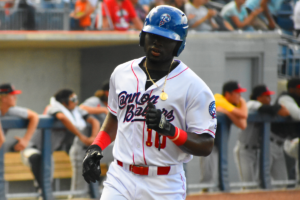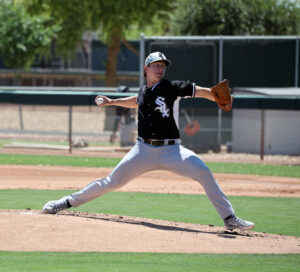Prospect Focus: Kade McClure
The following is a report on right-handed starter Kade McClure, based on in-person viewing on April 10, video, interviews with Kade and his Pitching Coach, and chatting with scouts.

Background
McClure was born and grew up in the Cleveland area and played his college ball at Louisville. In his third and final year for the Cardinals, he started 18 games, posting a 3.58 ERA and striking out 111 batters in 103 innings. The White Sox drafted him in the 6th round in 2017, but paid him a $330,000 bonus more in line with the 4th or 5th round (slot was $258,100). On a pitching limit due to a full college spring season, Kade threw just 11 innings as a pro in his draft year across AZL, Great Falls and finishing in Kannapolis. He opened 2018 as the first starter in the Intimidators rotation.
Mechanical/Physical
McClure is listed at 6’7″, and having stood next to him that seems about right. His movements on the field are surprisingly athletic given his height, and he appears to have a healthy build. When he’s using his better mechanics (more on that soon) he releases at high three-quarters nearing overhand. From the second inning on, his delivery looked to repeat pretty consistently, which is key for a guy his height, especially at starter-level innings. His effort level looks fairly low, so what he’s delivering in velocity, he is doing without pressing for more. He was able to maintain his velocity throughout his start, which is also a positive sign of endurance in his first full professional season.
Here is an open side view of his mechanics:
The Game I Saw
Kade’s start on April 10th (his second of the year) is a good example of why you shouldn’t read a whole lot into minor league stats. His final line was 5 IP, 7 H, 3 R (1 ER), 2 BB, 7 K, with 56 of 75 pitches for strikes. It was also not as much one outing, as two. First, about those hits: six of the seven were ground balls that found gaps in the infield, and the other was a duck snort bloop hit. Very few times were the Asheville hitters able to really barrel anything. And three of the hits came in the 1st inning before even the 2nd out was recorded.
Enter Jose Bautista.
The Kannapolis Pitching Coach has been in the White Sox system, bouncing from affiliate to affiliate in that P.C. role, for years. I’ve spoken with him a number of times. He is brusque, honest, and a little gnarly, but he’s also a fountain of knowledge. After five of the first six Tourists reached base against our protagonist, his mentor in this story paid a visit to the mound. Now let’s take a look at Mr. McClure’s pitching lines before, and after, said visit:
- 0.1 IP, 3 H, 2 R, 1 BB, 0 K
- 4.1 IP, 4 H, 1 R, 1 BB, 6 K
Of course as noted earlier, those hits in the first inning were all ground ball base hits, and there was an error in there too that added an extra base for a runner. But a couple of those ground balls were hit pretty hard, and he did walk in a run. His command looked iffy, and his breaking pitches were flattening out. So what did Bautista say on that mound visit? Here is Kade’s version of the story:
He just said, keep getting ground balls. They got three kinda bouncing hits up the middle, so, I just tried to keep it at that. Not let it frustrate me, just help the defense make the plays.
There’s genius in the simplicity of the message. He didn’t tell him to throw strikes – he told him to get ground balls, which is to say, make the hitters hit. He also is telling a 6’7″ guy to pitch in a way that induces grounders, which functionally means getting more over the top to create better downward plane. But he didn’t tell him something mechanical to focus on, instead relying on Kade to use his already-built-in instincts and just aim at a goal.
As I reviewed my notes about McClure’s offspeeds flattening out a bit but getting sharper as the game went on, I went back to the video, and saw something that made that quote even better. In those early at-bats when he was getting hit a bit and walked in a run, his arm angle was lower than it was later in the game. Here is a video from before Bautista’s first visit:
And here is just a couple batters later:
The difference isn’t huge, but if you re-play the videos a few times it becomes clear. I did that so you don’t have to, but feel free.
When McClure gets his release point closer to true overhand, this accomplishes a few nifty things. First, everything is “heavier”, which makes it difficult for hitters to square up his pitches. Second, his breaking pitch that from a lower slot becomes something like a Frisbee, now gets a two-plane break that favors the drop. Third, his change-up becomes something more of a fall-off-the-table offering, instead of a slow pitch that spends more time in the red zone. Finally, he takes away left-handed batters’ ability to get a cleaner read on the pitch.
Bautista got McClure to deliver on all of that, without filling his head with mechanical distractions. That is a great coaching moment.
Analysis By Pitch
Let’s break down each of McClure’s offerings. Keep in mind that what I’m going with here is what I saw post-mound visit. And before we start that, words from Kade on how he sees his repertoire:
I like to pitch off my fastballs a lot, I’d say like 70% of my pitches are fastballs. I like to establish that, make them beat that before I go to anything else. The change-up is the pitch I’ve been working on the most. In Spring Training and so far this year. I’d definitely like to get that better. Right now my slider or slurve is probably my second best pitch.
And here is what I observed:
- 4-seam Fastball: sat mostly 91-92 mph, a couple 90’s, but also touched as high as 94. Good sink and just a touch of fade. This is his bread-and-butter offering.
- 2-seam Fastball: not used often, came in at 87-89, has some cut to it in addition to sink.
- Slurve: Around 80-83, showed some nice late snap at times, but other times it was more of a bender. Work in progress, but there is potential there.
- Change-up: A tumbler at 83-85, like the slurve it wasn’t consistent in shape. All had some decent drop but some more than others, and the good ones also faded a bit.
The fastball combo is a good starting point for his arsenal. The velocity isn’t much right now, but like most starters, he will probably gain some velocity after this first full pro season. From his release point, a low 90’s fastball that can touch mid-90’s in that heavy character, will definitely work as the anchor of his arsenal. The 2-seamer didn’t show up for often enough to feel like I can comment much on it, but the fact that he can deliver it identically out of his hand and have that variation available helps load the tool bag.
The offspeed pitches need some work. Both looked at times like they’d mature into legit major league offers, while other times just didn’t bite much. For this level and his stage of development, that’s not a bad spot to be in.
Here is a video that shows most of his repertoire in an at-bat against highly-touted prospect Ryan Vilade:
In terms of command, when he’s in that higher arm slot, he finds the strike zone without much issue (good control). It was hard to read finer command at this point – he did put a few in the dirt and let a couple sail high, but it did seem like he was hitting the mitt’s original spot or close to it most of the time and worked both sides of the plate.
Status and Conclusion
First, since some folks have asked, I do believe McClure should remain a starter. Not only is there no good reason for him not to (he’s not blocking anyone and he needs reps in any case), but I think the framework is there for a good starter’s package. I like his fastball pair as projecting to at least major league average, and the change-up has a chance to get there too. The latter will allow him to work lefties more effectively.
The difference-maker is the answer to this question: what is his put-away pitch? Right now it’s that slurve, and it may still be in the future, but the current version will need more two-plane movement delivered consistently to work as the nail against major league hitters. Here is a quote from Kade about that breaker and how he uses it, acknowledging he’s still playing with balance a bit:
I threw kind of a loopy curve in high school, and when I got to college it kinda got banged around a little bit. I do have one I’ll try to flip in there early, but then I want to try to throw it a little harder later on, as a put-away pitch.
He will need to deliver it the same way he does his fastball, which could be hard given it’s as close to a big bender as it is to a classic slider and the arm speed will be a challenge to mask.
McClure is definitely a prospect, one with a chance to become a 4/5 starter in the majors if everything works. When we get to July and it’s time to make a new Top 30 White Sox Prospects list, even in a deep system he should be in the discussion for the back end of the list.
Want to know right away when we publish a new article? Type your email address in the box on the right-side bar (or at the bottom, if on a mobile device) and click the “create subscription” button. Our list is completely spam free, and you can opt out at any time.






